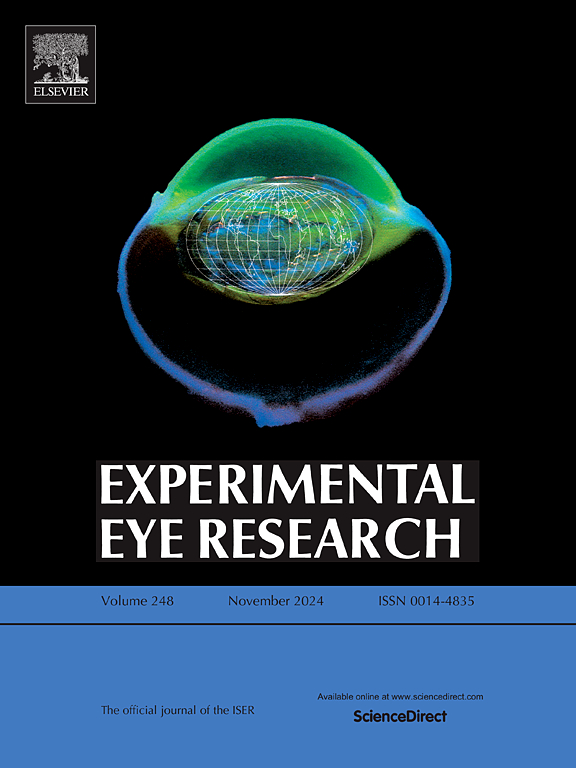Lycium barbarum glycopeptide alleviates retinal inflammation by suppressing microglial M1 polarization via NF-κB/MAPK pathways
IF 2.7
2区 医学
Q1 OPHTHALMOLOGY
引用次数: 0
Abstract
Lycium barbarum glycopeptide (LBGP) is a known glycoconjugate with various pharmacological benefits, notably anti-inflammatory properties, though its impact on retinal inflammatory conditions is not fully understood. This research evaluated the impact of LBGP on retinal inflammation using a diabetic retinopathy (DR) mouse model induced by streptozotocin (STZ), along with LPS/IFN-γ (L/I)-stimulated BV2 microglia and primary retinal microglia. In vivo, administration of LBGP effectively enhances retinal thickness, structure, and function in diabetic mice. Additionally, it prevents microglial activation and inflammation. In vitro, LBGP pretreatment significantly reversed L/I-induced morphological alterations in microglial area, perimeter, Feret's diameter, and roundness. LBGP significantly alleviated L/I-induced microglial activation in primary and BV2 microglia. LBGP shifted M1 pro-inflammatory phenotype to M2 anti-inflammatory phenotype by downregulating M1 markers (IL-6, IL-1β, iNOS, COX2, CD86, and CD16) and upregulating M2 markers (CD206 and arginase 1). Additionally, LBGP reduced the upregulation of NF-κB and MAPK pathways in L/I-stimulated BV2 microglial cells. Our study suggests that LBGP protects against microglial overactivation and diminishes the secretion of inflammatory molecules from microglia in vivo and vitro, potentially through attenuation of the NF-κB and MAPK signaling pathways.

枸杞糖肽通过NF-κB/MAPK通路抑制小胶质细胞M1极化,减轻视网膜炎症。
枸杞糖肽(LBGP)是一种已知的糖缀合物,具有多种药理作用,特别是抗炎特性,尽管其对视网膜炎症的影响尚不完全清楚。本研究利用链脲佐菌素(STZ)诱导的糖尿病视网膜病变(DR)小鼠模型,以及LPS/IFN-γ (L/I)刺激的BV-2小胶质细胞和原发性视网膜小胶质细胞,评估了LBGP对视网膜炎症的影响。在体内,给药LBGP可以有效地增强糖尿病小鼠视网膜的厚度、结构和功能。此外,它还能防止小胶质细胞的激活和炎症。在体外,LBGP预处理可显著逆转L/ i诱导的小胶质细胞面积、周长、Feret直径和圆度的形态学改变。LBGP显著减轻L/ i诱导的初级和BV2小胶质细胞的小胶质细胞活化。LBGP通过下调M1标记物(IL-6、IL-1β、iNOS、COX2、CD86和CD16)和上调M2标记物(CD206和精氨酸酶1)将M1促炎表型转变为M2抗炎表型。此外,LBGP降低了L/ i刺激的BV2小胶质细胞中NF-κB和MAPK通路的上调。我们的研究表明,在体内和体外,LBGP可能通过抑制NF-κB和MAPK信号通路,防止小胶质细胞过度激活,减少小胶质细胞炎症分子的分泌。
本文章由计算机程序翻译,如有差异,请以英文原文为准。
求助全文
约1分钟内获得全文
求助全文
来源期刊

Experimental eye research
医学-眼科学
CiteScore
6.80
自引率
5.90%
发文量
323
审稿时长
66 days
期刊介绍:
The primary goal of Experimental Eye Research is to publish original research papers on all aspects of experimental biology of the eye and ocular tissues that seek to define the mechanisms of normal function and/or disease. Studies of ocular tissues that encompass the disciplines of cell biology, developmental biology, genetics, molecular biology, physiology, biochemistry, biophysics, immunology or microbiology are most welcomed. Manuscripts that are purely clinical or in a surgical area of ophthalmology are not appropriate for submission to Experimental Eye Research and if received will be returned without review.
 求助内容:
求助内容: 应助结果提醒方式:
应助结果提醒方式:


